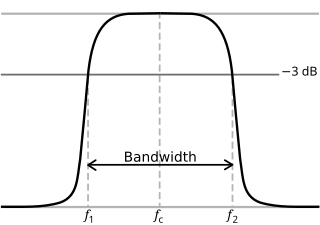
A | B | C | D | E | F | G | H | CH | I | J | K | L | M | N | O | P | Q | R | S | T | U | V | W | X | Y | Z | 0 | 1 | 2 | 3 | 4 | 5 | 6 | 7 | 8 | 9


In physics and electrical engineering, a cutoff frequency, corner frequency, or break frequency is a boundary in a system's frequency response at which energy flowing through the system begins to be reduced (attenuated or reflected) rather than passing through.
Typically in electronic systems such as filters and communication channels, cutoff frequency applies to an edge in a lowpass, highpass, bandpass, or band-stop characteristic – a frequency characterizing a boundary between a passband and a stopband. It is sometimes taken to be the point in the filter response where a transition band and passband meet, for example, as defined by a half-power point (a frequency for which the output of the circuit is approximately −3.01 dB of the nominal passband value). Alternatively, a stopband corner frequency may be specified as a point where a transition band and a stopband meet: a frequency for which the attenuation is larger than the required stopband attenuation, which for example may be 30 dB or 100 dB.
In the case of a waveguide or an antenna, the cutoff frequencies correspond to the lower and upper cutoff wavelengths.
Electronics
In electronics, cutoff frequency or corner frequency is the frequency either above or below which the power output of a circuit, such as a line, amplifier, or electronic filter has fallen to a given proportion of the power in the passband. Most frequently this proportion is one half the passband power, also referred to as the 3 dB point since a fall of 3 dB corresponds approximately to half power. As a voltage ratio this is a fall to of the passband voltage.[1] Other ratios besides the 3 dB point may also be relevant, for example see § Chebyshev filters below. Far from the cutoff frequency in the transition band, the rate of increase of attenuation (roll-off) with logarithm of frequency is asymptotic to a constant. For a first-order network, the roll-off is −20 dB per decade (−6 dB per octave.)
Single-pole transfer function example
The transfer function for the simplest low-pass filter,
At cutoff
Hence, the cutoff frequency is given by
Where s is the s-plane variable, ω is angular frequency and j is the imaginary unit.
Chebyshev filters
Sometimes other ratios are more convenient than the 3 dB point. For instance, in the case of the Chebyshev filter it is usual to define the cutoff frequency as the point after the last peak in the frequency response at which the level has fallen to the design value of the passband ripple. The amount of ripple in this class of filter can be set by the designer to any desired value, hence the ratio used could be any value.[2]
Radio communications
In radio communication, skywave communication is a technique in which radio waves are transmitted at an angle into the sky and reflected back to Earth by layers of charged particles in the ionosphere. In this context, the term cutoff frequency refers to the maximum usable frequency, the frequency above which a radio wave fails to reflect off the ionosphere at the incidence angle required for transmission between two specified points by reflection from the layer.
Waveguides
The cutoff frequency of an electromagnetic waveguide is the lowest frequency for which a mode will propagate in it. In fiber optics, it is more common to consider the cutoff wavelength, the maximum wavelength that will propagate in an optical fiber or waveguide. The cutoff frequency is found with the characteristic equation of the Helmholtz equation for electromagnetic waves, which is derived from the electromagnetic wave equation by setting the longitudinal wave number equal to zero and solving for the frequency. Thus, any exciting frequency lower than the cutoff frequency will attenuate, rather than propagate. The following derivation assumes lossless walls. The value of c, the speed of light, should be taken to be the group velocity of light in whatever material fills the waveguide.
For a rectangular waveguide, the cutoff frequency is
The cutoff frequency of the TM01 mode (next higher from dominant mode TE11) in a waveguide of circular cross-section (the transverse-magnetic mode with no angular dependence and lowest radial dependence) is given by
The dominant mode TE11 cutoff frequency is given by[3]
However, the dominant mode cutoff frequency can be reduced by the introduction of baffle inside the circular cross-section waveguide.[4] For a single-mode optical fiber, the cutoff wavelength is the wavelength at which the normalized frequency is approximately equal to 2.405.
Mathematical analysis
The starting point is the wave equation (which is derived from the Maxwell equations),
The "longitudinal" derivative in the Laplacian can further be reduced by considering only functions of the form
Antropológia
Aplikované vedy
Bibliometria
Dejiny vedy
Encyklopédie
Filozofia vedy
Forenzné vedy
Humanitné vedy
Knižničná veda
Kryogenika
Kryptológia
Kulturológia
Literárna veda
Medzidisciplinárne oblasti
Metódy kvantitatívnej analýzy
Metavedy
Metodika
Text je dostupný za podmienok Creative
Commons Attribution/Share-Alike License 3.0 Unported; prípadne za ďalších
podmienok.
Podrobnejšie informácie nájdete na stránke Podmienky
použitia.
www.astronomia.sk | www.biologia.sk | www.botanika.sk | www.dejiny.sk | www.economy.sk | www.elektrotechnika.sk | www.estetika.sk | www.farmakologia.sk | www.filozofia.sk | Fyzika | www.futurologia.sk | www.genetika.sk | www.chemia.sk | www.lingvistika.sk | www.politologia.sk | www.psychologia.sk | www.sexuologia.sk | www.sociologia.sk | www.veda.sk I www.zoologia.sk
























